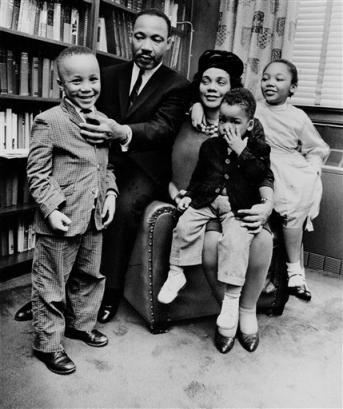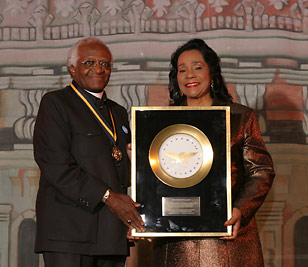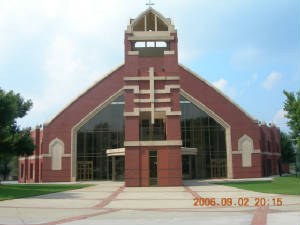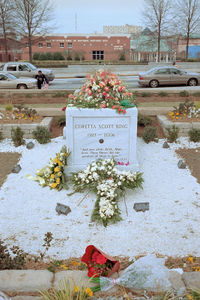|

click here to see pictures
The Kings were married on June 18, 1953 on the lawn of her parents house. She moved with her husband to Montgomery, Alabama
in September of 1954 after he was named pastor of the Dextor Avenue Baptist Church after she completed her degree in
voice and violin. They had four children who all followed their footsteps as civil rights activists. She received honorary
degrees from may institutes.
Coretta Scott King played an important role in the Civil rights Movemnent of the 1960s. Her husband wanted her to
stay home and raise their children while she wanted to become more involved in the civil rights movement. She continued to
carry on the Civil Rights legacy of her husband after his assasination in 1968.

After her husband was assasinated in 1968, Coretta began
attending a commemorative service at Ebenezer Baptist Church in Atlanta to mark her husband's birth every January 15 and fought
for years to make it a national holiday, a quest that was realized in 1986, when the first Martin Luther King Day was celebrated.
In 1986, she traveled to South Africa and met with Winnie Mandela, while Mandela's husband Nelson Mandela was still a political
prisoner on Robben Island.Coretta was vocal in her opposition to capital punishment
and the 2003 invasion of Iraq, thus drawing criticism from conservative groups. She was also an advocate of women's rights,
lesbian and gay rights and HIV/AIDS prevention. |
|
|

The 'Coretta Scott King Award', a medal presented by the American
Library Association, is awarded to African American writers and illustrators for outstanding and inspirational educational
contributions in children's literature. During the 1980s, Coretta reaffirmed her long-standing opposition to apartheid,
participating in a series of sit-in protests in Washington, D.C. that prompted nationwide demonstrations against South African
racial policies. |
|
|

Established in 1968 by Mrs. King, The King Center is the official
memorial dedicated to the advancement of the legacy and ideas of Martin Luther King, Jr., leader of a nonviolent movement
for justice, equality and peace.
As the institutional guardian of Dr. King's legacy, the King Center,
in collaboration with other organizations, focuses on the following areas:
- The development and dissemination of programs that educate the world
about Dr. King’s philosophy and methods of nonviolence, human relations, service to mankind, and related ideas;
- Building a national and international network of organizations that,
through sanctioned programs, promote, complement, and help further the organization’s mission and objectives of building
the Beloved Community that Dr. King envisioned
- Functioning as the clearinghouse for non-profit organizations and
government agencies which utilize Dr. King’s image and writings for programs and ensuring that the programs are historically
and interpretively accurate;
- Monitoring and reporting on the impact of Dr. King’s legacy
on the world.
|
|
|
By the end of her 77th year, Coretta began experiencing health
problems.She was hospitalized in April of 2005, diagnosed with a heart condition and was discharged on her
78th and final birthday. Later, Coretta suffered several small strokes. On August 16, 2005, she was hospitalized
after suffering a stroke and a mild heart attack. Initially, she was unable to speak or move her right side. She was released
from Piedmont Hospital in Atlanta on September 22, 2005, after regaining some of her speech and continued physiotherapy at
home. Due to continuing health problems, King cancelled a number of speaking engagements throughout the remainder of 2005.
Because of complications from the stroke, she was apparently unable to make her wishes known regarding the ongoing debate
as to whether of the King Center would continue to operate independently or be sold to the National Park Service. On January
14, 2006, Mrs. King made her last public appearance in Atlanta at a dinner honoring her husband's memory. |
|
|
Mrs. King died in the late evening of January 30, 2006 at a rehabilitation
center in Rosarito Beach, Mexico, where she was undergoing holistic therapy for her stroke and advanced stage ovarian cancer.
The main cause of death is believed to be respiratory failure. Coretta was 78. The clinic at which she passed away was
the 'Hospital Santa Monica.' Newspaper reports indicated that it was 'not licensed to provide much more than basic walk-in
medical services.' The clinic was not legally licensed to 'perform surgery, take X-rays, perform laboratory work or run an
internal pharmacy, all of which it was doing.' Days after Mrs. King's death, the Baja California, Mexico state medical
commissioner, Dr. Francisco Vera, shut down the clinic. |
|
|

Over 14,000 people gathered for King's six-hour funeral at the New
Birth Missionary Baptist Church in Lithonia, Georgia on February 7, 2006 . The megachurch whose sanctuary seats 10,000 was
better able to handle the expected massive crowds than Ebenezer Baptist Church where King had been a member since the early
1960s up to her death and which was the site of Martin Luther King, Jr.'s funeral in 1968.The current and most former U.S.
Presidents and their wives attended, excepting the Ford family because of an illness and Barbara Bush dealing with conflicts
in Orlando. Other political and civil right leaders attended the televised service.Mrs. King was buried in a temporary
mausoleum on the grounds of the King Center until a permanent place next to her husband's remains could be built. She
had expressed to her family members and others that she wanted her remains to lie next to her husband's at the King Center.
On November 20, 2006 the new mausoleum containing both the bodies of Dr. and Mrs King was unveiled in front of friends and
family. |
|
|
|
 |
|





